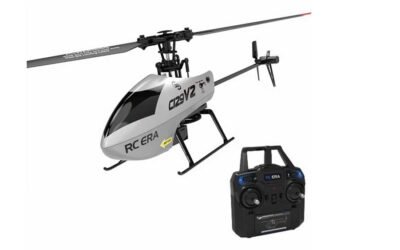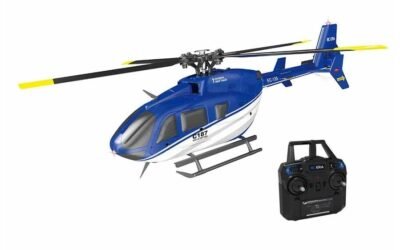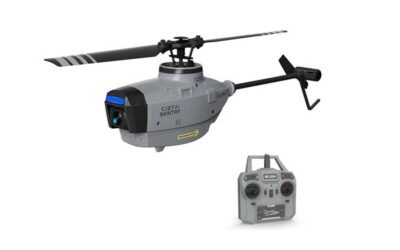The Amazing World of RC Helicopter Communication
The article “RC Helicopter Communication Protocols” explores various protocols like PWM, PPM, DSM, FHSS, and brand-specific ones. It discusses factors like range, interference resistance, compatibility, and cost, along with technology trends in RC communications.
“Flying an RC Helicopter: It’s all about the right frequency.”


Introduction: Taking Off Into the World of RC Helicopters
Hello, fellow RC enthusiasts and aspiring pilots! Are you ready to dive into the thrilling world of RC helicopters? If you’re nodding your head (or your helicopter’s rotor), you’re in for a treat! In this article, we’re not just talking about any aspect of RC helicopters; we’re delving into the heart and soul of these amazing machines: communication protocols.
Now, I know what you’re thinking: “Protocols? Sounds like a snooze fest!” But trust me, understanding communication protocols is like having a secret key to unlock the full potential of your RC helicopter. It’s the difference between a smooth, responsive flight and one where your helicopter seems to have a mind of its own (and not in a good way). So, buckle up and let’s explore this electrifying world together!
Basics of Communication Protocols in RC Helicopters: Decoding the Invisible Language
When we talk about communication protocols in RC helicopters, we’re essentially discussing the invisible language through which your remote control whispers sweet nothings (or stern commands) to your helicopter. It’s a world where milliseconds matter, and the right protocol can make your helicopter dance in the sky like a leaf in the wind.
Analog vs. Digital: The Age-Old Rivalry
First up, let’s break down the basics: Analog and Digital protocols – the yin and yang of RC communication.
- Analog Protocols (PWM and PPM): Picture these as the wise, old masters of the RC world. They’ve been around since the dawn of remote-controlled flight. Simple yet effective, these protocols control your chopper using varying pulse lengths. But beware, they’re like that one uncle who can’t keep up with the latest tech; they’re more prone to interference and less precise than their digital counterparts.
- Digital Protocols (PCM): Enter the digital era! PCM, or Pulse Code Modulation, is like the cool, tech-savvy kid on the block. It communicates using a series of digital signals, offering a much more stable and precise control. Think of it as texting versus sending a telegram.
Beyond Basics: The Digital Evolution
As we step into the digital domain, things get really exciting. We’re talking about protocols like DSM (DSM2, DSMX), and FHSS. These are the Ferraris of the RC world – sleek, fast, and with a need for speed. DSM, for instance, is like having a private, encrypted chat with your helicopter, ensuring no one else interferes. And FHSS? It’s the master of disguise, constantly changing frequencies to dodge any electronic eavesdroppers.
Brand-Specific Protocols: Loyalty Has Its Perks
Now, here’s where brand loyalty comes into play. Many manufacturers have developed their own secret sauces, their unique protocols that work best with their equipment. FrSky with its ACCST technology is like the Swiss Army knife of protocols – versatile and reliable. And FlySky’s AFHDS? It’s the budget-friendly, dependable choice for many. Each of these has its own flavor and perks, catering to different needs and styles.
In the world of RC helicopters, communication protocols are your invisible, yet powerful allies. Choosing the right one can elevate your flying experience to new heights. So, as you embark on this journey, remember: it’s not just about the helicopter; it’s about the harmony between your transmitter and receiver, a duet that brings your flying dreams to life.
Stay tuned as we dive deeper into the nuances of these protocols in the upcoming sections, where we’ll compare, contrast, and maybe even crack a few jokes about these technological marvels! 🚁✨

Types of Protocols and Their Characteristics: The Secret Language of RC Helicopters
Understanding the Language of the Skies
Welcome back, rotorheads! Are you ready to decode more of the secret language of RC helicopters? In this section, we’ll embark on an exciting journey through the diverse world of communication protocols. Trust me, it’s more exhilarating than trying to perform a barrel roll on your first flight!
Traditional Protocols: The Stalwarts of the Sky
Let’s start with the veterans of the communication world – the traditional protocols.
- PWM (Pulse Width Modulation): Imagine PWM as the Morse code of the RC world. It uses varying pulse widths to communicate with servos. Simple and straightforward, but, like your grandpa’s old radio, it’s not the best at handling interference.
- PPM (Pulse Position Modulation): PPM is the slightly more sophisticated cousin of PWM. It combines multiple PWM signals into one, reducing the cable spaghetti mess. But, it still shares a bit of its cousin’s vulnerability to noise – like attending a rock concert with earplugs, it helps, but you’ll still hear the noise.
- PCM (Pulse Code Modulation): PCM is like the digital upgrade to analog signals. It’s precise, it’s sophisticated, and it’s less likely to get confused by electronic chitchat happening around it.
Advanced Digital Protocols: The High-Flyers
Now, onto the crème de la crème of RC protocols – the digital masterpieces.
- DSM (DSM2, DSMX): Developed by Spektrum, DSM protocols are like having a secret, encrypted line to your helicopter. DSM2 uses two frequencies for data transmission, while DSMX plays it even safer, hopping across up to 60 frequencies. It’s like playing musical chairs with frequencies, and your helicopter always finds a seat!
- FHSS (Frequency Hopping Spread Spectrum): FHSS, used by giants like Futaba, is the master of disguise in the protocol world. It hops frequencies to avoid interference – think of it as your helicopter playing a high-stakes game of hide and seek with potential signal disruptors.
Brand-Specific Protocols: The Signature Moves
Each manufacturer has its own signature protocol, kind of like how every pilot has their unique flying style.
- FrSky (ACCST, D8, D16): FrSky, known for its cost-effective solutions, offers protocols like ACCST (Advanced Continuous Channel Shifting Technology). With different modes like D8 and D16, it’s like having a swiss army knife for communication – versatile and reliable.
- FlySky (AFHDS, AFHDS-2A): FlySky’s AFHDS (Automatic Frequency Hopping Digital System) is the trusty steed of the budget-conscious pilot. It’s like having a reliable, fuel-efficient car – it gets the job done without breaking the bank.
The Perfect Protocol: Choosing Your Invisible Co-Pilot
Choosing the right protocol is like picking a dance partner – it needs to match your rhythm and style. Consider factors like range, interference resilience, and, of course, compatibility with your gear. It’s a bit like dating – you might have to try a few before you find “the one.”
In Conclusion: Embracing the Language of the Skies
There you have it, friends – a whirlwind tour of the most popular communication protocols in the RC helicopter world. Each protocol has its unique charm and quirks, much like the helicopters they control. Remember, the right protocol can make your flying experience as smooth as a perfectly executed hover, or as erratic as a newbie’s first flight in a windstorm.
So, as you continue your journey in the mesmerizing world of RC helicopters, think of your communication protocol as your trusty sidekick, invisibly guiding your flights to new heights of excitement and skill. Until next time, keep your rotors spinning and your signals clear! 🚁💫

Factors Influencing Protocol Choice: Picking the Perfect Partner for Your RC Helicopter
Making the Right Match: Factors to Consider
Hello, RC aficionados! Let’s talk about choosing the perfect communication protocol for your beloved chopper. It’s like online dating for RC helicopters – you’ve got to find the one that really clicks with your flying style and needs.
Range: How Far Can Your Love Go?
Range is like the long-distance relationship of the RC world. You want a protocol that stays connected, whether your helicopter is a stone’s throw away or soaring at the edge of your line of sight.
Interference Resistance: Dodging the RC Relationship Drama
In the crowded airspace of signals, you need a protocol that can tune out the gossip. Protocols with frequency hopping like FHSS are like that cool friend who stays calm in a crowded room.
Model Compatibility: The Heart Wants What It Wants
Your helicopter and protocol need to be compatible, like two puzzle pieces fitting together. Ensure that your chosen protocol speaks the same language as your RC model – it’s essential for a harmonious relationship.
Cost: Love Don’t Cost a Thing, But Protocols Do
Consider your budget. Some protocols, like DSMX or ACCST, might be the Ferraris of the sky, but there are also reliable ‘sedans’ like FlySky’s AFHDS for the budget-conscious pilot.
Technology Evolution and Trends in Protocols: The Future is Now!
From Morse Code to AI: The Evolution of RC Communication
Are you ready to zoom into the future of RC helicopter communication? Strap in as we take off into the ever-evolving landscape of communication protocols!
The Good Old Days: A Nostalgic Look Back
Remember the days of PWM and PPM? They were like the rotary phones of the RC world – reliable in their time but lacking the finesse of modern technology.
The Digital Revolution: A New Era in RC Communication
Digital protocols like DSMX and FHSS changed the game. They brought precision and reliability, making flying as smooth as streaming your favorite song online.
The Trendsetters: Emerging Technologies in RC Communication
Now, we’re looking at even more exciting developments:
- Telemetry Integration: Imagine your helicopter sending real-time data back to you – it’s like getting live updates from your chopper on its health and environment.
- Smartphone Integration: Control your helicopter with your phone? Yes, please! It’s like having a universal remote, but cooler.
- AI and Machine Learning: Future protocols might use AI to optimize communication, making your helicopter smarter than ever – think of it as having a mini Einstein onboard.
Looking Ahead: What’s on the Horizon?
The future is bright and buzzing with possibilities:
- Ultra-Long-Range Communication: We might see protocols that let you control your helicopter from miles away – talk about long-distance relationships!
- Enhanced Interference Resistance: New protocols might be so good at avoiding interference, they could fly through a tech convention without a hiccup.
- Eco-Friendly Technologies: As we become more conscious of our environmental impact, look out for greener communication methods that reduce electronic waste.
In Conclusion: Flying Into the Future
The world of RC helicopters is evolving faster than a spinning rotor. With new technologies emerging, who knows what incredible advancements we’ll see next? One thing’s for sure: the future of RC helicopter communication looks as thrilling as a perfectly executed loop-the-loop. Stay tuned, pilots – the best is yet to come! 🚁🌟

Comparative Analysis of Protocols: The RC Helicopter Protocol Showdown
The Ultimate Protocol Face-Off
Welcome back, sky conquerors! Let’s roll up our sleeves and jump into the ring for a head-to-head comparison of the top communication protocols in the RC helicopter world. It’s like having a “Top Chef” contest, but for RC protocols!
Range Rumble: Who Goes the Distance?
- DSMX and FHSS: These guys are the marathon runners of the RC world. They offer excellent range and are perfect for those who love to let their helicopters stretch their wings.
- PWM and PPM: Think of these as your friendly neighborhood joggers. They’re good for a casual flight but might not keep up in a long-range sprint.
Interference Immunity: The Battle Against Noise
- FHSS and DSMX: These protocols dodge interference like ninjas, thanks to their frequency-hopping skills.
- PCM: It’s like having a solid defense line in a football game. It’s pretty robust against interference but might not be as agile as FHSS.
Cost Comparison: Bang for Your Buck
- FlySky (AFHDS): The budget-friendly choice. It’s like getting a great deal on a smartphone that does everything you need.
- FrSky (ACCST): A bit more of an investment, but it’s like upgrading to a smartphone with a few more bells and whistles.
Compatibility Clash: Finding the Perfect Match
- Brand-specific protocols: They’re like loyal companions, working best with their own kind. Make sure your gear is compatible before committing!
- Universal protocols: These are the social butterflies, compatible with a wider range of models.
Challenges and Solutions in RC Helicopter Communication: Navigating Turbulent Skies
Overcoming Common Communication Hurdles
Hey, RC heroes! Every pilot faces challenges, but fear not – we’ve got some tips to navigate these turbulent skies.
- Interference Issues: If you’re battling signal interference, consider switching to a frequency-hopping protocol like FHSS or DSMX. It’s like having a secret path through a crowded room.
- Range Limitations: Feeling tethered? Extend your horizons with long-range protocols. Just make sure your battery can keep up with your adventurous spirit!
- Compatibility Conundrums: Got a mismatch? Double-check compatibility before buying. It’s like making sure your dance partner knows the same dance as you.
Conclusion: Soaring High in the World of RC Communication
And that’s a wrap, folks! From the basics to the cutting-edge, we’ve explored the vast and exciting world of RC helicopter communication protocols. Remember, the right protocol is the wind beneath your helicopter’s rotors. So, choose wisely, fly boldly, and keep reaching for the skies! 🚁💫
FAQs
FAQ1: What are RC Helicopter Communication Protocols?
- RC helicopter communication protocols are systems that enable control signal transmission from the transmitter to the helicopter’s receiver.
FAQ2: What are Some Common RC Helicopter Protocols?
- Common protocols include PWM, PPM, DSM (DSM2, DSMX), FHSS, and brand-specific ones like FrSky and FlySky.
FAQ3: What Factors Should I Consider When Choosing a Protocol?
- Consider range, interference resistance, compatibility with your helicopter, and cost when selecting a protocol.
der transfers to your computer’s hard drive through your Web browser (if you allow) that enables the sites or service providers systems to recognize your browser and capture and remember certain information

You may be interested in an Advanced Digital Gyroscope
Don’t miss out on the thrill of piloting your own sky adventure – RC Helicopter City offers an exhilarating blend of skill, precision, and fun, perfect for both beginners and seasoned enthusiasts. Embrace the joy of flight today and experience the unmatched excitement of controlling your very own high-performance RC helicopter, a hobby that promises endless hours of entertainment and skill development.
You May Also Like
Related Posts
RC ERA C129 V2 Review: What Makes It Stand Out
Explore the RC ERA C129 V2’s advanced features, its suitability for beginners, and how it’s revolutionizing remote-controlled flight.
Why Choose RC ERA C187 for Your Hobby
Explore the exciting world of the RC ERA C187 Helicopter. This guide offers tips, reviews, and techniques for beginners and pros alike.
RC ERA C127AI Review: Tech Specs and User Feedback
Explore the revolutionary RC ERA C127AI with advanced tech, user-friendly features, and expert reviews. Learn why it’s the top choice for RC enthusiasts.




0 Comments